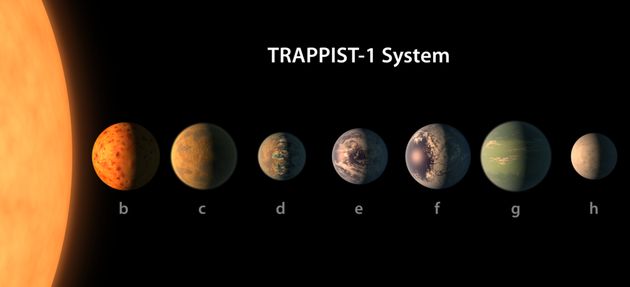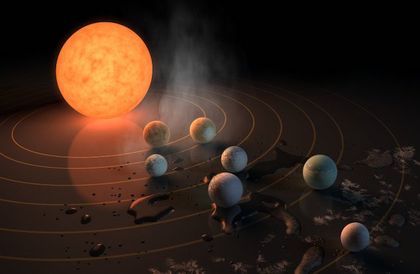At about 40 light-years from Earth, it is possible that some of them could have water on their surface.
 Planets are named from 1b to 1h in order of their distance from TRAPPIST-1. / NASA
Planets are named from 1b to 1h in order of their distance from TRAPPIST-1. / NASA
NASA's Spitzer Space Telescope has revealed the first known system of seven Earth-size planets around a single star.
All of these seven planets could have liquid water – key to life as we know it – under the right atmospheric conditions, but three of these planets are firmly located in the habitable zone, the area around the parent star where a rocky planet is most likely to have liquid water.
The discovery sets a new record for greatest number of habitable-zone planets found around a single star outside our solar system.
The new results were published Wednesday in the journal Nature, and announced at a news briefing at NASA Headquarters in Washington.
EXOPLANETS
At about 40 light-years from Earth, the system of planets is relatively close to us, in the constellation Aquarius. Because they are located outside of our solar system, these planets are scientifically known as exoplanets.
This exoplanet system is called TRAPPIST-1, named for The Transiting Planets and Planetesimals Small Telescope (TRAPPIST) in Chile.
In May 2016, researchers using TRAPPIST announced they had discovered three planets in the system. Assisted by several ground-based telescopes, including the European Southern Observatory's Very Large Telescope, Spitzer confirmed the existence of two of these planets and discovered five additional ones, increasing the number of known planets in the system to seven.
 The TRAPPIST-1 star, an ultra-cool dwarf, has seven Earth-size planets orbiting it. / NASA
The TRAPPIST-1 star, an ultra-cool dwarf, has seven Earth-size planets orbiting it. / NASA
FIRST TIME
All seven planets were detected by watching how their star dims as each passes — or transits — in front of it. Scientists measured how much of the star’s light each transit blocked from Earth’s view. Knowing how big a planet would have to be to do that, the astronomer calculated that all seven must have roughly the same radius as Earth.
In contrast to our sun, the TRAPPIST-1 star – classified as an ultra-cool dwarf – is so cool that liquid water could survive on planets orbiting very close to it, closer than is possible on planets in our solar system.
"This is the first time that so many Earth-sized planets are found around the same star", says Michael Gillon, lead author of the paper and the principal investigator of the TRAPPIST exoplanet survey at the University of Liege, Belgium.
"It is also the best target yet for studying the atmospheres of potentially habitable, Earth-size worlds", he adds.
LIQUID WATER?
Named from 1b to 1h in order of their distance from TRAPPIST-1, the planets take between 1.5 to 20 days to completely orbit the star — a time that is less than what it takes our Moon to orbit Earth.
All seven of the TRAPPIST-1 planetary orbits are closer to their host star than Mercury is to our sun. The planets also are very close to each other.
Because the planets are so close to this cooler star, they receive similar amounts of energy as the inner planets in our solar system. This means it is possible that some of the alien planets could have water on their surface.
"The energy output from dwarf stars like TRAPPIST-1 is much weaker than that of our sun. Planets would need to be in far closer orbits than we see in the solar system if there is to be surface water. Fortunately, it seems that this kind of compact configuration is just what we see around TRAPPIST-1", Amaury Triaud, one of the co-authors of the Nature paper, states.
“SUPRISINGLY SIMILAR IN SIZE TO THE EARTH”
The six inner rocky planets are located in the temperate zone, where the surface temperature could be between 0 and 100 degrees Celsius.
“The three inner-most planets may be too hot to have water covering the entire surface, but the fourth, fifth and sixth planets all fall well within the Goldilocks zone, which makes them very good candidates for hosting life”, explains Dr Gillion.
The seventh planet, however, is likely to be too distant and cold to harbour liquid water unless there is some internal mechanism or atmosphere to keep the planet warm. Its mass has not yet been estimated, but scientists believe it could be an icy, "snowball-like" world, although further observations are needed.
"This is an amazing planetary system — not only because we have found so many planets, but because they are all surprisingly similar in size to the Earth", Dr Gillon points out.
JUST THE BEGINING
"The TRAPPIST-1 system provides one of the best opportunities in the next decade to study the atmospheres around Earth-size planets", said Nikole Lewis, co-leader of the Hubble study and astronomer at the Space Telescope Science Institute in Baltimore, Maryland.
NASA's planet-hunting Kepler space telescope also is studying the TRAPPIST-1 system, making measurements of the star's minuscule changes in brightness due to transiting planets.
Spitzer, Hubble, and Kepler will help astronomers plan for follow-up studies using NASA's upcoming James Webb Space Telescope, launching in 2018.
With much greater sensitivity, Webb will be able to detect the chemical fingerprints of water, methane, oxygen, ozone, and other components of a planet's atmosphere. Webb also will analyse planets' temperatures and surface pressures – key factors in assessing their habitability.

Las opiniones vertidas por nuestros colaboradores se realizan a nivel personal, pudiendo coincidir o no con la postura de la dirección de Protestante Digital.
Si quieres comentar o